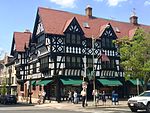Princeton Township, New Jersey

Princeton Township was a township in Mercer County, New Jersey, United States, that existed from 1838 until the end of 2012. On January 1, 2013, it merged with the Borough of Princeton to form Princeton, New Jersey; both Princeton Township and the Borough of Princeton were dissolved in the merger. As of the 2010 United States Census, the township's population was 16,265, reflecting an increase of 238 (+1.5%) from the 16,027 counted in the 2000 Census, which had in turn increased by 2,829 (+21.4%) from the 13,198 counted in the 1990 Census.Princeton was incorporated as a township by an act of the New Jersey Legislature on April 9, 1838, from portions of West Windsor Township in Mercer County and Montgomery Township in Somerset County. The Borough of Princeton — created on February 11, 1813 within the area that later became Princeton Township — became a fully independent municipality circa 1894. Portions of territory were ceded to the Borough of Princeton on January 4, 1928 and August 21, 1951. On November 8, 2011, voters in Princeton Township voted to consolidate with Princeton Borough, a change that took effect on January 1, 2013.The Institute for Advanced Study, a private research institution that has been an academic home to Albert Einstein, Kurt Gödel, and many other famous and prize-winning scientists, is located in the former township. Princeton University is located mostly within the former borough, but parts of the campus extended into what was Princeton Township. Drumthwacket, the official residence of the governor of New Jersey, is located at 344 Stockton Street in the area of the former township.The last day Princeton Township existed as an independent municipality was December 31, 2012.
Excerpt from the Wikipedia article Princeton Township, New Jersey (License: CC BY-SA 3.0, Authors, Images).Princeton Township, New Jersey
Bayard Lane,
Geographical coordinates (GPS) Address Nearby Places Show on map
Geographical coordinates (GPS)
| Latitude | Longitude |
|---|---|
| N 40.357115 ° | E -74.670165 ° |
Address
Bayard Lane 215
08540
New Jersey, United States
Open on Google Maps










